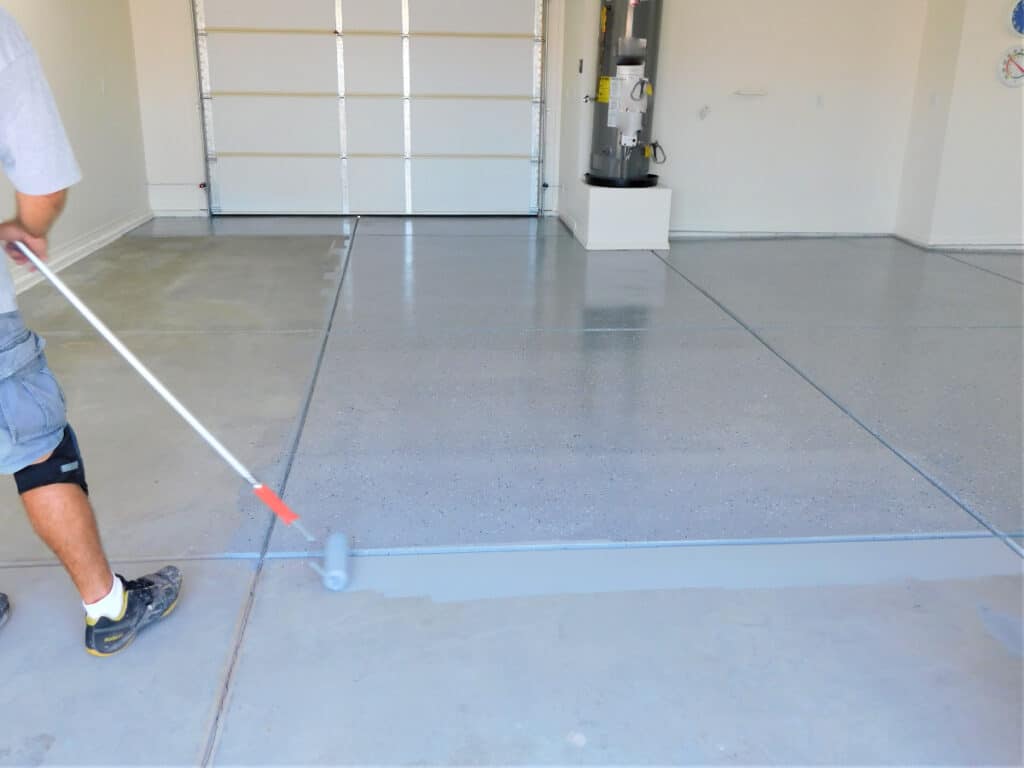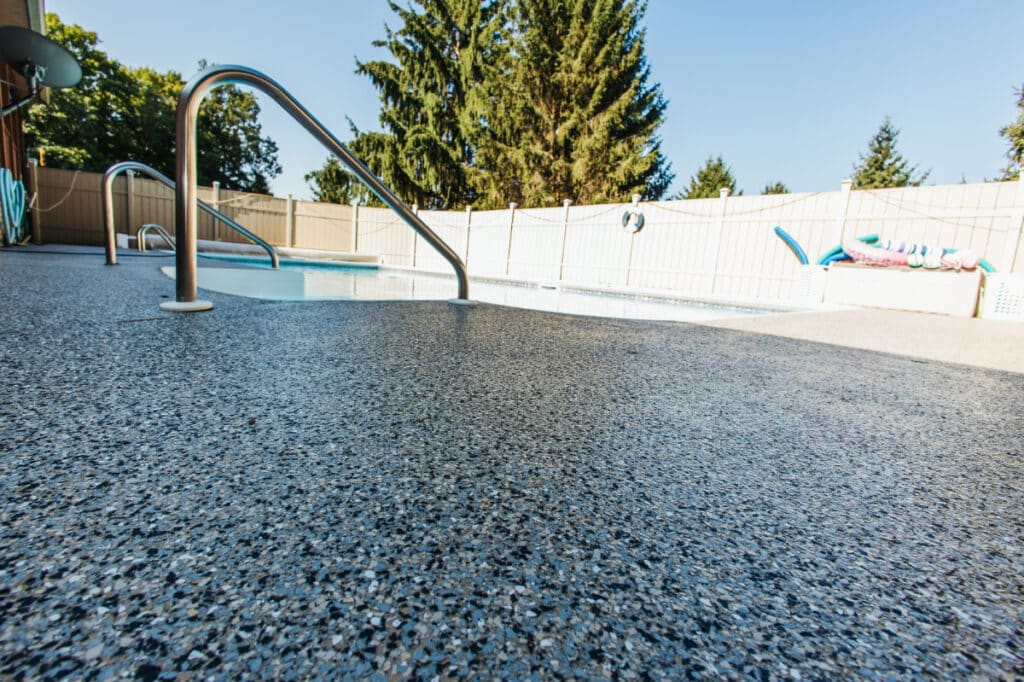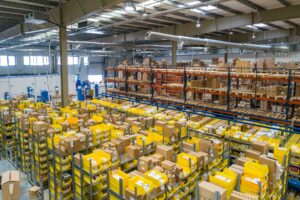Considering epoxy flooring for your garage, basement, or patio? Epoxy is a popular option, particularly for DIY projects, and has many traits that make it appealing as a flooring solution for bare concrete.
But epoxy is no longer the preferred solution for concrete floor coatings, and polyaspartic coatings have supplanted epoxy for a variety of reasons!
Before deciding, it may be helpful to understand the disadvantages of epoxy flooring. This article explores these drawbacks to help you make an informed choice between epoxy and its alternatives.
A Demanding Installation Process and Long Curing Time
Installing an epoxy flooring system requires meticulous preparation and adherence to specific conditions. Even minor mistakes can reduce the floor’s durability, leading to costly repairs or replacements. This makes the installation process demanding and risky, especially for non-professionals considering epoxy floor coatings.
A significant challenge is moisture sensitivity. High humidity during installation can cause the epoxy to sweat and form blisters. Excess moisture in the concrete can lead to “efflorescence”, causing the epoxy to detach from the surface over time.
Proper surface preparation is an essential—and time-consuming—part of the epoxy adhesion process. Using a sealant or waterproofing agent on concrete before applying the epoxy can help prevent moisture-related issues. Better yet, make sure the concrete is very dry beforehand (we use a moisture meter).
Epoxy floors take a long time to cure, dry, and set—sometimes more than a week! In contrast, modern alternatives like polyaspartic coatings can cure in just a few hours.
Susceptibility to UV Damage and UV Yellowing
One often overlooked disadvantage of epoxy flooring is its susceptibility to UV damage. While epoxy floors may look stunning when first installed, exposing them to UV radiation from sunlight can cause the floors to yellow and degrade over time. Imagine investing in a beautiful floor only to see it turn yellow and lose its luster after a few years.
UV degradation affects not just appearance but also the flooring’s integrity, leading to increased damage from wear and tear. Additionally, the application of epoxy resin can release harmful fumes, adding another layer of inconvenience and risk.
This susceptibility is a major drawback for those seeking long-lasting, visually-appealing flooring in areas that receive a lot of direct sunlight like garages or daylight basements.
Hot Tire Wear
Epoxy flooring and hot tires are a bad match.
Hot tire wear, also known as hot tire pickup, occurs when vehicle tire heat causes the epoxy coating to peel or delaminate over time. This issue is particularly common in garage floors with frequent vehicular movement, leading to pitting and cracking over time.
For areas that get a lot of vehicular traffic, even though epoxy floors are extremely durable, they can be more trouble than they’re worth.
Epoxy Flooring Sensitivity to Temperature Changes
Temperature changes can impact epoxy flooring. Warm conditions can cause epoxy to sag on vertical surfaces, creating an uneven finish. Conversely, cooler conditions slow down the curing process, leading to bubbles in the coating layer, known as outgassing.
Epoxy is incredibly HARD. That sounds like a good thing, but it’s actually so hard that it can’t tolerate small fluctuations in the underlying concrete that occurs with changing temperatures and seasons. Cold and hot cause concrete to expand and contract slightly. Polyaspartic coatings, but contrast, flex with the movement of the concrete, meaning much less risk of cracking.
This sensitivity to temperature variations means epoxy flooring’s performance and appearance can vary with environmental conditions. For regions with significant temperature fluctuations, this is a major concern.
Cost Considerations

It’s important to understand the true cost of epoxy beyond the sticker price.
Installation typically costs between $3 to $12 per square foot, but labor costs can represent up to 65% of the total project cost.
Preparatory work, including concrete repairs, can add between $6 to $14 per square foot before epoxy installation. Additionally, site preparation may add another $1 to $5 per square foot. Traffic coatings for high-traffic areas can increase the cost by approximately 20% to 30% compared to other types of sealants.
And if epoxy cracks and pits, you’re looking at an expensive repair to maintain the integrity of the floor.
While epoxy is durable and popular in the past, the initial investment and potential future costs should be carefully weighed against other flooring options.
Moisture Sensitivity
Moisture sensitivity is a critical issue for epoxy flooring. Before installation, checking humidity levels is crucial to prevent adhesion issues. Moisture trapped in concrete floors can cause the epoxy to lift and peel, leading to costly repairs and renovations.
Caution: Slippery When Wet
Epoxy floors can be slippery when wet, which can be a safety hazard, especially in areas with high foot traffic or where water is present.
This is because epoxy is a non-porous material. To mitigate this risk, we can add a textured or non-slip coating to the concrete floor coating, especially in areas prone to moisture, such as garages.
Maintenance and Upkeep of Epoxy Floors
Epoxy floors are relatively easy to maintain, but they do require regular cleaning to keep them looking their best. To clean an epoxy floor, use a mild detergent and warm water. Avoid wildly harsh chemicals or abrasive cleaners, as they can damage the epoxy coating.
Regular sweeping or vacuuming is the easiest way to remove dirt and debris that can scratch the floor.
Polyaspartic: The Superior Choice to Epoxy

Given the numerous disadvantages of epoxy flooring, polyaspartic coatings offer some real advantages over traditional epoxy floors!
Polyaspartic coatings are the modern alternative to epoxy. They demonstrate enhanced UV stability, better impact resistance, and quicker curing times compared to epoxy. They are more adaptable to varying temperatures and heavy traffic, too. Unlike epoxy, polyaspartic coatings possess inherent flexibility that accommodates the natural expansion and contraction of concrete due to temperature variations, minimizing cracking. They also avoid the hot tire pickup issue that plagues epoxy coatings.
Another significant advantage of polyaspartic coatings is the amount of customization options. They allow for decorative chips in various colors, shapes, and patterns during application, providing an aesthetically pleasing and highly functional flooring solution!
Everlast Concrete Coatings: New York’s Polyaspartic Specialists
While an epoxy floor coating offers some great benefits over bare concrete, these days epoxy has a host of disadvantages that can affect its performance and longevity – especially compared to modern polyasapartic.
From the demanding installation process and susceptibility to UV damage to the problems of hot tire wear and moisture sensitivity, these issues can make epoxy flooring a less-than-ideal choice for many applications.
Polyaspartic coatings are the superior alternative. With enhanced durability, quicker curing times, and better resistance to temperature changes and UV exposure, polyaspartic coatings offer a long-lasting, low-maintenance flooring solution. If you’re considering a new flooring system, this is the clear choice.
If you’re in the Finger Lakes of New York State and seeking a professional, experienced local company to coat your basement, patio, or garage floor, give us a call. We use only the best, most advanced polyaspartic coatings to create stunning and durable surfaces. With a 15-year warranty on every project, you can rest easy knowing you’ve got a true, professional installation.





